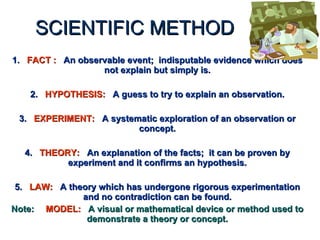
Chem presentation1 introduction By: Sir PJ De Castro
- 1. SCIENTIFIC METHOD 1. FACT : An observable event; indisputable evidence which does not explain but simply is. 2. HYPOTHESIS: A guess to try to explain an observation. 3. EXPERIMENT: A systematic exploration of an observation or concept. 4. THEORY: An explanation of the facts; it can be proven by experiment and it confirms an hypothesis. 5. LAW: A theory which has undergone rigorous experimentation and no contradiction can be found. Note: MODEL: A visual or mathematical device or method used to demonstrate a theory or concept.
- 3. EXPERIMENTS In ancient Greece philosophers, like Aristotle, did very little physical experimentation. Mental exercises were the preferred method for solving problems. SCIENTIFIC METHOD depends on experimentation therefore the ability to make measurements is vital when using scientific method .
- 4. THE DEVELOPMENT OF MODERN CHEMISTRY
- 7. Greek theory (600 B.C. to 300 B.C.) Plato proposed that the atom of one element differ in shape from the atom of another. He further believed that atom of one element could be changed into atoms f another by changing the shape of the atom. The concept of transmutation also found in Aristotle's theories. However, he did not believed in the existence of atom.
- 8. Greek theory (600 B.C. to 300 B.C.) To Aristotle, the form included not only shape but also qualities such as color and hardness that distinguish one from others. Throughout the Middle ages, it was believed that mineral could grow and that mines would be replenished after minerals were removed from them.
- 10. Alchemy (300BC to 1650 AD) Alchemist believed that a metal could be change by changing its qualities and that such change occur in nature-the metal strives from the perfection represented by gold.
- 11. Alchemy (300BC to 1650 AD) In the 7 th century AD, the Arabs conquered the centers of Hellenistic civilization and alchemy passed into their hands. The Arabs called the philosopher’s “ aliksir ” (which was later corrupted into “ elixir ”. Arab alchemists believed that this substance could not only ennoble metals by transmuting them into gold but could also ennoble life by curing all diseases.
- 12. For centuries afterwards, the two principal goals of alchemy were the transmutation of base metals into gold and the discovery of the elixir of life that could make human s immortal by preventing death.
- 13. A school of iatrochemistry, a branch of alchemy concerned with medicine into the 16 th and 17 th centuries. Alchemy lasted until the 17 th century. Gradually the theories and attitudes of the alchemists began to be questioned. The work of Robert Boyle, who published The Sceptical Chymist in 1661 is noteworthy. Boyle emphasized that chemical theory should be drieved from experimental evidence.
- 14. PHLOGISTON?
- 15. PHLOGISTON THEORY Involved a weightless or nearly weightless substance known as phlogiston. Metals and fire were considered to be rich in phlogiston and earth was considered oxygen poor.
- 16. When metal is calcined, or roasted in the presence of air, it turns to a powdery substance called a calx (now known as an oxide). This reduction in weight was explained as a loss of phlogiston into the air. For the smelting of an ore, the process reversed. Charcoal was believed to be rich in phlogiston and so, when charcoal was burned with this powdery calx, phlogiston supposedly passed from the charcoal to the calx restoring the metal. It was believed that….
- 18. MAJOR PROBLEM The problem was that when some metals were calcined, the resulting calx was heavier than the initial metal. Some proponents of the phlogiston theory tried to explain this phenomena by saying that in some metals, phlogiston has negative weight. It was discovered that mercury could be turned back into a metal simply by heating it, that is without a phlogiston rich source such as charcoal. Rather than except this theory that phlogiston could have positive weight, negative weight, and sometimes no weight at all,
- 19. Lavoisier suspected and later proved that the weight increase was a result of the metal combining with air. In 1777 Lavoisier presented his theory that combustion and related processes were reactions in which oxygen combines with other elements in a paper entitled Memoir on Combustion in General.
- 20. SOLUTION : LAW OF CONSERVATION OF MASS Laviosier changed chemistry from a qualitative to a quantitative science. He freed society from the disillusionment of the phlogiston theory by showing that the mass of the products in a reaction are equal to the mass of the reactants. The following diagram uses the example of mercury calx to show the major difference between the mental model used by Priestly and the one developed by Lavoisier. Therefore, Lavoisier proved that oxygen played the major role in the differences in weight associated with combustion, disproving the accepted view of the Phlogiston Theory.
- 21. Welcome to the World of Chemistry
